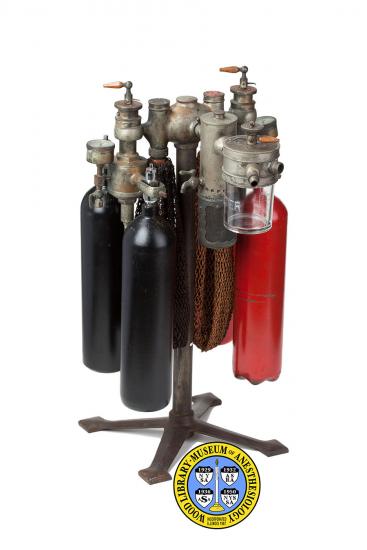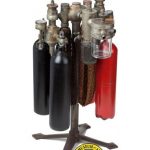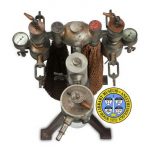Teter Apparatus
Dr. Charles K. Teter (1875-1959) and his brother Dr. William C. Teter (1873-1954) were both dentists who specialized in oral surgery and anesthesia. In 1908, they patented an apparatus to deliver nitrous oxide, oxygen and ether. It may have been the first machine to include all three of these agents. This became the standard combination for all anesthesia machines made over the next two decades. The model shown here is the Teter Regulated Pressure Apparatus, introduced around 1912.
Dr. Charles Teter was internationally known as an expert in nitrous oxide-oxygen anesthesia, and is credited with convincing the influential surgeon Dr. George Washington Crile (1864-1943) to use this method. He served as Vice President of the newly-formed American Association of Anesthetists in 1913 and 1914, and became its second President in 1915. This organization later became the International Anesthesia Research Society.
The Teter brothers’ apparatus inspired the development of new machines. In 1906, Dr. Jay Heidbrink (1875-1957) made his first machine, a modification of the Teter, which became the Heidbrink Anesthetizer. In 1910, Dr. Crile's nurse anesthetist, Ms. Agatha Hodgins, helped to design the Ohio Monovalve.
Catalog Record: Teter Apparatus
Access Key: akxi
Accession No.: 2011-05-20-1
Title: [Teter regulated pressure apparatus / designed by Charles K. Teter.]
Author: Teter, Charles K., 1875-1959.
Author: Teter, William C., 1873-1954.
Corporate Author: The Teter Manufacturing Company.
Title variation: Alt Title
Title: Teter regulated pressure gas apparatus.
Title variation: Alt Title
Title: Teter regulated pressure gas-oxygen outfit.
Title variation: Alt Title
Title: Teter apparatus no. 2.
Title variation: Alt Title
Title: Teter pressure regulated apparatus.
Publisher: Cleveland, Ohio : Teter Manufacturing Co., [between 1912 and 1930?].
Physical Descript: 1 anesthesia machine : cast iron, other metals, glass, textile (cotton?),
rubber, wood, paint ; 81 x 45 x 57 cm.
Subject: Nitrous Oxide.
Subject: Oxygen.
Subject: Ether, Ethyl.
Subject: Anesthesia Machines.
Note Type: General
Notes: The early date in the date range for the possible year of manufacture is
based on the earliest advertisement found for the “Teter Regulated Pressure
Apparatus” (a 1912 JAMA advertisement). Advertisements and mention of the
Teter regulated pressure apparatus decline significantly during the 1920s.
The later year in the date range (1930) is an estimate based on this. The
date range could change if documentation indicates that it should be
corrected.
Note Type: General
Notes: The title is taken from the earliest advertisement found for the “Teter
Regulated Pressure Apparatus” (a 1912 JAMA advertisement).
Note Type: Citation
Notes: Announcement of the Teter regulated pressure apparatus [advertisement]. JAMA.
November 23, 1912;59(21):page 33 of ads.
Note Type: Citation
Notes: Smith WDA. A history of nitrous oxide and oxygen anaesthesia: part xii:
developments in America and nitrous oxide anaesthesia between world wars. Br
J Anaesth. 1972;44(2):215-221.
Note Type: Citation
Notes: Stebbins HM. Charles K. Teter, D.D.S. J Am Dent Soc Anesthesiol. January
1958;5(1):15-16.
Note Type: Citation
Notes: Teter CK. Apparatus for administering anesthetics. US patent 706,358. August
5, 1902. www.google.com/patents/US706358. Accessed January 14, 2015.
Note Type: Citation
Notes: Teter CK. Apparatus for administering anesthetics. US patent 883,987. April 7
1908. www.google.com/patents/US883987. Accessed January 14, 2015.
Note Type: Citation
Notes: Teter CK. Facial inhaler. US patent 1,244,661. October 30, 1917. www.google.
com/patents/US1244661. Accessed January 14, 2015.
Note Type: Citation
Notes: Teter CK. Nasal inhaler. US patent 731,973. June 23, 1903. www.google.
com/patents/US731973. Accessed January 14, 2015.
Note Type: Citation
Notes: Teter CK. Pharyngeal inhaler. US patent 1,270,565. June 25, 1918. www.google.
com/patents/US1270565. Accessed January 14, 2015.
Note Type: Citation
Notes: The Teter regulated pressure gas apparatus [advertisement]. Oral Hygiene: A
Journal for Dentists. February, 1914;4(2):152. https://books.google.
com/books?id=9k9EAQAAIAAJ&dq=%22Teter+Manufacturing+Co%22&source=gbs_navlinks
s. Accessed April 29, 2014.
Note Type: Citation
Notes: The Teter regulated pressure gas-oxygen outfit [advertisement]. Am Yearb
Anesth Analg: 1915. New York City: Surgery Publishing Company; 1916:page xv
of ads.
Note Type: Physical Description
Notes: [1] One anesthesia machine; The overall measurements were taken from the
perspective of facing the ether vaporizer; The glass jar of the vaporizer is
embossed with the word, “TETER”; The jar is also marked in frosted lettering
and the increments 1, 2, 4, 6, 8, 10, 12 “OZ”; The vaporizer has two areas
for control at the top; The upper most area is a dial; At ‘zero degrees’ is
an increment that is marked, “BOTH OPEN” (Please note that the increments
around this dial are not numbered. The degrees are used by the cataloger for
descriptive purposes only.); There are increment marks on the right at
approximately 40, 80, 120, and 160 degrees; At the 160 degree mark is, “TO
MOUTH”; Between the 160 and 200 degree marks is the word, “TUBE”; At the 200
degree mark is, “TO INHALER”; There are also increment marks at approximately
240, 280, and 320 degrees; The metal pointer in the center of this dial can
be turned to any point along the dial; Below this upper dial, the ether
vaporizer also has a lower dial; The pointer for this lower dial is metal at
the pointer-end and wood at the other end; This dial is marked, “ETHER
PERCENTAGES [new line] B [new line] ATTACHMENT”; Along the face of the dial
are increments numbered from 1 to 20; Just before increment zero is, “ALL O &
N2O”; In some space before and above the 1, 2 and 3 increment marks is an
arrow that is labeled, and points to the, “OUTLET TO MOUTH TUBE”; In some
space above and near the 18, 19 and 20 increment marks is an arrow that is
labeled and points to the, “OUTLET TO INHALER”; Between the ether inhaler and
the head of the machine is a cylindrical vapor warmer; At the very base of
the warmer is a cylindrical wire mesh cage; The metal of the mesh cage is
blacked from use; This was likely an alcohol fueled warmer; A downward curved
spout exits the base of the solid portion of the vapor warmer; The spout is
topped by a turning lever for the valve; The vapor warmer connects to the
center of the head of the machine at the mixing chamber; On the other side of
the mixing chamber is an oval metal plate with the following manufacturer
markings, “THE TETER MANUFACTURING CO. [new line] CLEVELAND, OHIO [new line]
MACHINE NO. 7101 [new line] U.S. AND FOREIGN PATENTS [new line] AUG. 5 – 1902
[tab] OCT. 13 – 1902. [new line] JUNE 20 – 1903. [tab] SEPT. 21 – 1903. [new
line] APR. 7 – 1908. [tab] DEC 28 – 1908. [new line] MAR. 31 – 1908.”; On the
left side of the head are two yokes for nitrous oxide cylinders, a pressure
gauze, a pressure regulator, and a control valve; The nitrous oxide control
valve has a wooden turn lever and metal pointer; The face of the valve is
marked, “N2O [new line] GAL. PER HR. AT 25 LBS.”; The pointer can be adjusted
to a scale on the valve marked from 0 to 240, with the following increments
numbered: 40, 80, 120, 160, 200, and 240; Between the nitrous oxide control
valve and the mixing chamber is a black colored valve marked, “N2O”, with an
arrow marked “OPEN” pointing toward the mixing chamber and an arrow marked
“CLOSED” pointing toward the back of the machine; A rubber bag covered in a
textile net is attached to the machine directly below this valve; On the
right side of the head are two yokes for oxygen cylinders, a pressure gauge,
a pressure regulator, and a control valve; The oxygen control valve has a
wooden turn lever and a metal pointer; The face of the valve is marked
“OXYGEN [new line] GAL. PER HR. AT 25 LBS.”; The oxygen pointer can be
adjusted along a scale on the valve; Neither the starting increment nor the
end increment are marked or numbered; An increment marked “100” is located
half way between what is likely the zero increment and the end increment; The
following increments are numbered: 12, 25, 40, 60, and 100; … [physical
description continued at 2].
Note Type: Physical Description
Notes: [2, physical description continued from 1] … Between the oxygen control
valve and the mixing chamber is a red colored valve marked, “OXYGEN”, with an
arrow marked “OPEN” pointing toward the mixing chamber and an arrow marked
“CLOSED” pointing toward the back of the machine; A rubber bag covered in a
textile net is attached to the machine directly below this valve; The head of
the machine is attached to the pole of a four legged stand at the bottom of
the mixing chamber; All of the metals of the machine some corrosion or
rusting.
Note Type: Reproduction
Notes: Photographed by Mr. Steve Donisch, September 20, 2013.
Note Type: Acquisition
Notes: Donated to the WLM by William Neff, MD.
Note Type: Historical
Notes: In 1902, just two years after graduating from dental school, Charles K. Teter
patented his first anesthesia apparatus. It supported two gas cylinders, such
as one containing oxygen (O2) and one nitrous oxide (N2O). Teter, an Ohio
native, became a recognized expert in, and an advocate for, the
administration of nitrous oxide and oxygen for dental and surgical anesthesia
Teter’s original apparatus was followed by a number of improved machines,
including the “Teter Regulated Pressure Apparatus” pictured here.
Introduced in 1912, the Teter Regulated Pressure Apparatus included two yokes
for oxygen cylinders and two for nitrous oxide, regulating valves for each
gas, an ether vaporizer and a vapor warmer. Teter also designed a number of
accessories to use with his anesthesia machines, including a nasal inhaler,
pharyngeal tubes, and an oronasal mask.
Charles K. Teter (1875-1959) taught widely and wrote a number of articles
about his technique for the administration of N2O and O2. One of his better
known articles, published in a 1909 issue of JAMA, was titled, “Thirteen
Thousand Administrations of Nitrous Oxide with Oxygen as an Anesthetic.”
Note Type: Publication
Notes: Sunrise slumber: the Teter method for painless childbirth [advertisement for
The Teter Gas-Oxygen Obstetrical Apparatus]. Surg Gynecol Obstet. February,
1917;24(2):page 9 of ads.https://books.google.
com/books?id=5aUCAAAAYAAJ&dq=%22Teter+Manufacturing+Co%22&source=gbs_navlinks
s. Accessed April 29, 2014.
Note Type: Publication
Notes: Teter CK, Davies DA. Apparatus for heating nitrous oxid administering
appliances. US patent 1,082,482. December 23, 1913. www.google.
com/patents/US1082482. Accessed January 14, 2015.
Note Type: Publication
Notes: Teter CK, inventor. Teter Manufacturing Company, assignee. Apparatus for
administering Anaesthetics. US patent 1,593,680. July 27, 1926. https://www.
google.
com/patents/US1593680?pg=PA3&dq=%22Teter+Manufacturing%22&hl=en&sa=X&ei=ZOpfU
eNEoresASknYKABA&ved=0CEQQ6AEwAw. Accessed April 29, 2014.
Note Type: Exhibition
Notes: Exhibited in the WLM Park Ridge gallery on Northwest Highway from 1999-2014;
Selected for the WLM website.



